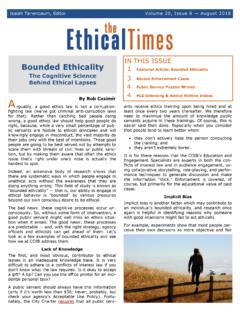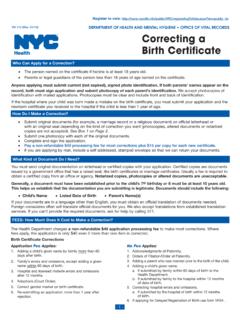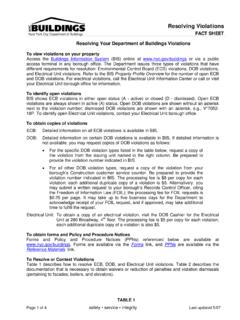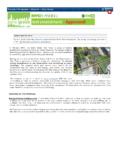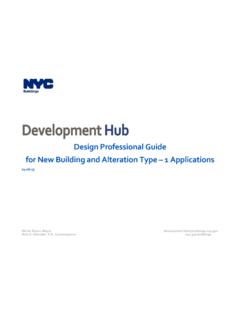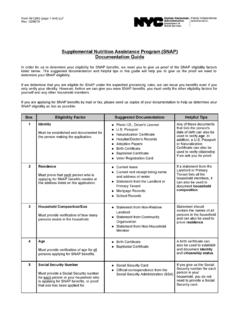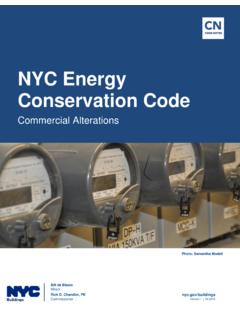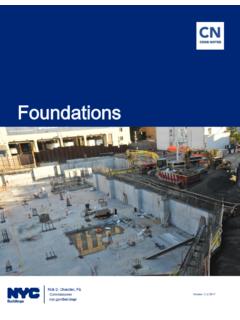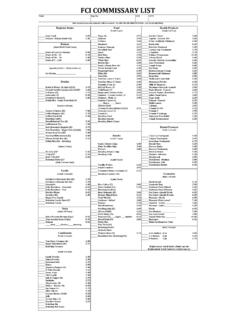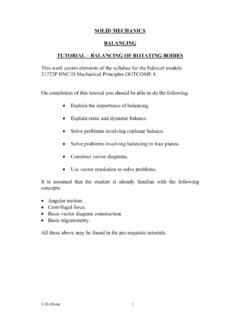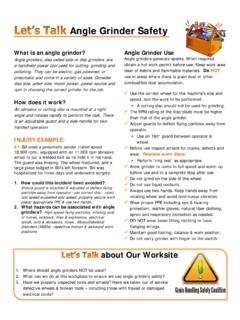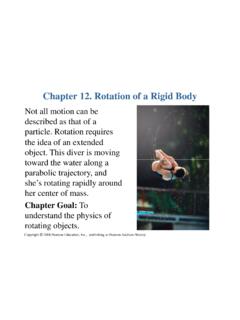Transcription of 1 RCNY §3319-01
1 1 RCNY 3319-01. CHAPTER 3300. Safeguards during Construction or Demolition 3319-01 Cranes and derricks. (a) Applicability. The design, construction, permitting, installation, removal, adjustment, repair, inspection, maintenance, operation and use of cranes and derricks must conform to the requirements of Section 3319 of the New York City Building Code and this section. This includes, but is not limited to, cranes and derricks used for hoisting and/or rigging purposes; or used for construction, alteration, demolition, excavation and maintenance purposes, including for buildings, highways or sewers; or used for the installation of piles; or used for the hoisting or lowering of any article on the outside of any building or structure.
2 This also includes any equipment that meets the definition of a crane or derrick, including, but not limited to, dedicated pile drivers and manufactured or custom designed hoisting machines. Exception: Cranes and derricks listed in the exceptions set forth in Section of the New York City Building Code. (b) Definitions. For the purposes of this section, the following terms have the following meanings: ACCEPTANCE OR ACCEPTED (Construction documents). See Section of the Administrative Code. ACCESSORY. A secondary part or assembly of parts which contributes to the overall function and usefulness of a machine. APPOINTED. Assigned specific responsibilities by the employer or by the employer's representative.
3 APPROVAL OR APPROVED (Construction documents). See Section of the Administrative Code. ANGLE INDICATOR (boom). An accessory which measures the angle of the boom to the horizontal. ARCHITECT. A person licensed and registered to practice the profession of architecture under the education law of the state of New York. ASSEMBLY/DISASSEMBLY (ASSEMBLED OR DISASSEMBLED). The installation or removal of structural components or attachments to a crane or derrick, or the installation or removal of elements that connect or attach a crane or derrick to a building or structure. The term assembly/disassembly includes the erection, climbing, jumping, or dismantling of a tower crane.
4 The term assembly/disassembly does not include operations exclusive to the installation or removal counterweights, or to the unfolding and pinning of a boom or swing-away jib. The term assembly/disassembly also does not include the setup or breakdown of a self-erecting tower crane provided the setup of the self-erecting tower crane does not require a boom, mast, or jib section, or other attachment, to be installed at the site. ATTACHMENTS. Elements that can be readily added to or removed from a crane or derrick and which expand the range or function of the crane or derrick. Examples include, but are not limited to: an auger, boom extension, clamshell, drill, jib, jib extension, or pile-driver.
5 AXIS OF ROTATION. The vertical axis around which the crane superstructure rotates. AXLE. The shaft or spindle with which or about which a wheel rotates. On truck and wheel mounted cranes it refers to an automotive type of axle assembly including housing, gearing, differential, bearings and mounting appurtenances. AXLE (bogie). Two or more automotive type axles mounted in tandem in a frame so as to divide the load between the axles and permit vertical oscillation of the wheels. BASE (mounting). The base or carrier on which the rotating superstructure is mounted such as a truck, crawler or platform. BOOM. A section or strut, of which the heel (lower end) is affixed to a base, carriage or support, and whose upper end supports a cable and sheaves where the load is lifted by means of wire rope and a hook.
6 BOOM ANGLE. The angle between the longitudinal centerline of the boom and the horizontal. The boom longitudinal centerline is a straight line between the boom foot pin (heel pin) centerline, and boom point sheave pin centerline. BOOM HARNESS. The block and sheave arrangement on the boom point to which the topping lift cable is reeved for lowering and raising the boom. BOOM HOIST. A hoist drum and rope reeving system used to raise and lower the boom. BOOM POINT. The outward end of the top section of the boom, containing the hoist sheave assembly. BOOM STOP. A device used to limit the angle of the boom at the highest position. BRAKE. A device used for retarding or stopping motion by friction or power means.
7 CAB. A housing which covers the rotating superstructure machinery and/or operators station. CABLEWAY. A power operated system for moving loads in a generally horizontal direction in which the loads are conveyed on an overhead cable, track or carriage. CERTIFICATE OF APPROVAL. A certificate issued by the department upon review and approval of the engineering and testing of a specific make and model of hoisting equipment to ensure compliance with the applicable provisions of this code and its referenced standards. CERTIFICATE OF OPERATION. A certificate issued by the department annually upon satisfactory inspection of the hoisting equipment holding a certificate of approval to ensure that the equipment continues to be in compliance with this code and its referenced standards.
8 CERTIFICATE OF ON-SITE INSPECTION. A certificate issued by the department based on a site-specific approval of the placement, founding and operation of hoisting equipment. CLAMSHELL. A shovel bucket with two jaws that clamp together by their own weight when it is lifted by a closing line. CLIMBING/JUMPING. The raising or lowering of a tower or climber crane to different floors or levels of a building or structure. CLUTCH. A friction, electromagnetic, hydraulic, pneumatic or positive mechanical device for engagement of power. COMPETENT PERSON. One who is capable of identifying existing predictable hazards in the surroundings or conditions that are unsanitary, hazardous or dangerous, and who has authorization to take prompt corrective measures to eliminate such hazards.
9 COMPONENT. A structural part or mechanical system that is integral to the crane or derrick, or an element that supports an integral structural part or mechanical system. Examples include, but are not limited to: a-frame, attachments, boom, boom tip, braking system, climbing frame or section, climbing mechanism, collar, counter jibs, counterweight, counterweight support system, engine, heel boom, hoist drum, hoist motor, machine deck or platform, mast, operator's cabin, pendant bars (excluding wire rope pendants), suspension system, tower base/base frame, tower top, and turntable. For a derrick, a component also includes base plates, junctions, poles and other uprights, seats, and stiff legs.
10 COUNTERWEIGHT. Weight used to supplement the weight of the machine in providing stability for lifting working loads. CRANE. A power-operated machine for lifting or lowering a load and moving it horizontally which utilizes wire rope and in which the hoisting mechanism is an integral part of the machine. The definition of a crane shall also include articulating boom crane, regardless of whether it has a hoisting mechanism integral to the machine. ARTICULATING BOOM CRANE. A power-operated machine for lifting or lowering a load and moving it horizontally that utilizes a boom consisting of a series of folding pin connected structural members, typically manipulated to extend or retract by power from hydraulic cylinders, with or without a hoisting mechanism integral to the machine.
